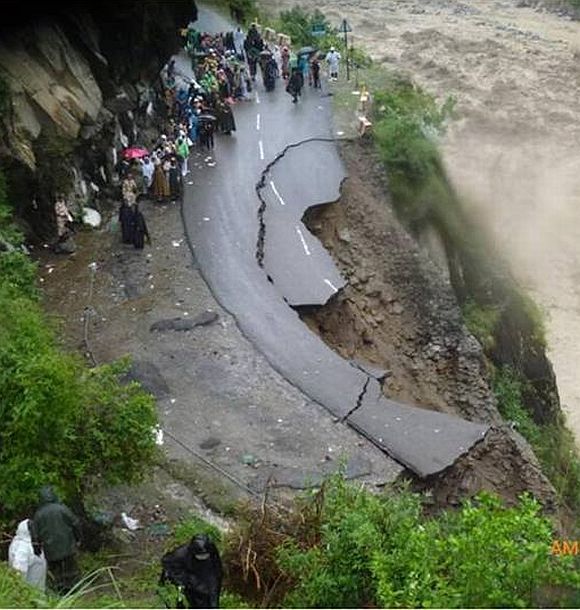 The weather office on Monday forecast heavy to very heavy rainfall over the next three days over some parts of Uttarakhand, which is still recovering from a deluge last week that is feared to have taken over 1,000 lives.
The weather office on Monday forecast heavy to very heavy rainfall over the next three days over some parts of Uttarakhand, which is still recovering from a deluge last week that is feared to have taken over 1,000 lives.
"Heavy to very heavy rainfall, of up to 25 cm, would occur at one or two places over Uttarakhand during the next 72 hours," the India Meteorological Department said in its forecast update on Monday afternoon.
An IMD handbook on Weather Terminologies "one or two places" refers to isolated rainfall with less than 25 per cent of weather stations experiencing the rains as forecast.
However, an IMD spokesman said the rainfall would not be as severe as of June 17, which triggered flash floods in the mountainous state and left a trail of death and destruction. In its forecast issued on Monday morning, the weather office warned of "severe" rainfall for Uttarakhand for three days beginning on Monday.
It has updated the warning to "very severe" in the forecast issued in the afternoon.
The weather office has also forecast heavy rainfall at one or two places over Sub-Himalayan West Bengal and Sikkim, Assam, Meghalaya, Nagaland, Tripura, north coastal Andhra Pradesh, coastal Karnataka and Kerala.
It has also forecast heavy to very heavy rainfall at one or two places over Odisha, Madhya Pradesh, Chhattisgarh, Vidarbha and Telangana.
Till Sunday, Uttarakhand had received 392 mm rainfall as against the normal of 104.2 mm, which is 275 per cent excess. Meanwhile, the country's disaster management chief has said that lives could have been saved if the weather office had issued precise forecasts.
"They (India meteorological department) need to develop a more precise observational and forecasting capability," M Shashidhar Reddy, Vice Chairman, National Disaster Management Authority said.
He said the IMD followed a standard format of weather forecast and used certain terminologies like rainfall, heavy rainfall, but "how are we supposed to translate it into action? They need to pinpoint where and how much it is going to rain."
Reddy was addressing the inaugural session of the South Asia Regional Consultation on Climate Change Adaptation. When asked about CAG's criticism of NDMA's functioning in its recent report, Reddy admitted to gaps in disaster preparedness level of the agency.
"As far as our shortcomings are concerned, we are ready to work on it," he said, adding that the government auditor needed to be sensitised about disasters.
There is a table in the Comptroller and Auditor General report which lists India's major disasters in the last ten years and I am surprised they haven't mentioned the 2005 Mumbai floods which indicates that people in CAG need to become sensitive," he said.
David Mcloughlin, deputy representative, United Nations International Children's Emergency Fund India and Convener of India's United Nations Disaster Management Team, lauded the government's efforts in carrying out the rescue operations.
Mcloughlin said, "Government's response to the crisis was robust given the criticality of the situation, difficult geographical structure and the large number of people involved. But I feel the government has done exceptionally well in handling this crisis.
He also emphasised on developing community resilience, which would help to prepare individuals for disaster at the local level.
"For this, we have been doing workshops which are meant to make people aware about the outcome of their actions and also to prepare them for such calamities," he said.
More than 140 delegates from eight South Asian Association for Regional Cooperation member nations, including representatives from national governments and United Nations had gathered for a four-day consultation focusing on climate change adaptation.
The event is organised by the United Nations Disaster Management Team and UNICEF in coordination with the ministry of environment and forest, ministry of home affairs, DMA and SAARCDisasterManagementCenter.










